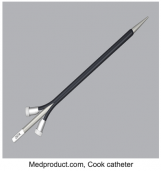Suprapubic Catheter Placement
Suprapubic Catheter Placement Basics
Dr. Valeria Chew
Indications
Need for bladder drainage / irrigation in a patient with:
- Urethral injuries (iatrogenic, trauma)
- Urethral strictures
- Obstructing prostate disease
- Obstructing lesions (ie malignancy)
- Phimosis
- Urethral foreign body
Contraindications
- Empty bladder (or unable to visualize)
- Bowel anterior to bladder
- Overlying infection/lesions
What you’ll need
- Ultrasound
- Analgesia (lidocaine)
- Urine bag
- Foley catheter
- Sterile syringe
- Scalpel
- Sterile gloves
- Skin prep (chlorhexidine, etc)
- Dressing
- Peel away catheter:

**If you don’t have this, use Seldinger technique with central access kit
Steps
1. Ultrasound, visualize bladder
2. Prep
3. Numb site with wheal
4. Use spinal needle & negative pressure on syringe, when you hit urine, stop
5. Guidewire through needle, remove needle
6. Scalpel to open site
7. Place introducer and in-dwelling dilator, remove dilator
8. Put foley into introducer, peel introducer it away
9. Aspirate foley to confirm placement, Inflate balloon
10. Dress site
11. Attach urine bag of choice
** For emergent decompression without a foley, aspirate urine at step 4 and stop if needed.
References
Aguilera PA, Choi T, Durham BA: Ultrasound-guided suprapubic cystostomy catheter placement in the emergency department. J Emerg Med 2004;26(3):319–321.
Suprapubic Bladder Catheterization (Percutaneous Cystostomy). In: Reichman EF. Reichman E.F.(Ed.),Ed. Eric F. Reichman.eds. Emergency Medicine Procedures, 2e. McGraw Hill; 2013. Accessed October 01, 2021. https://accessemergencymedicine.mhmedical.com/content.aspx?bookid=683&se...
